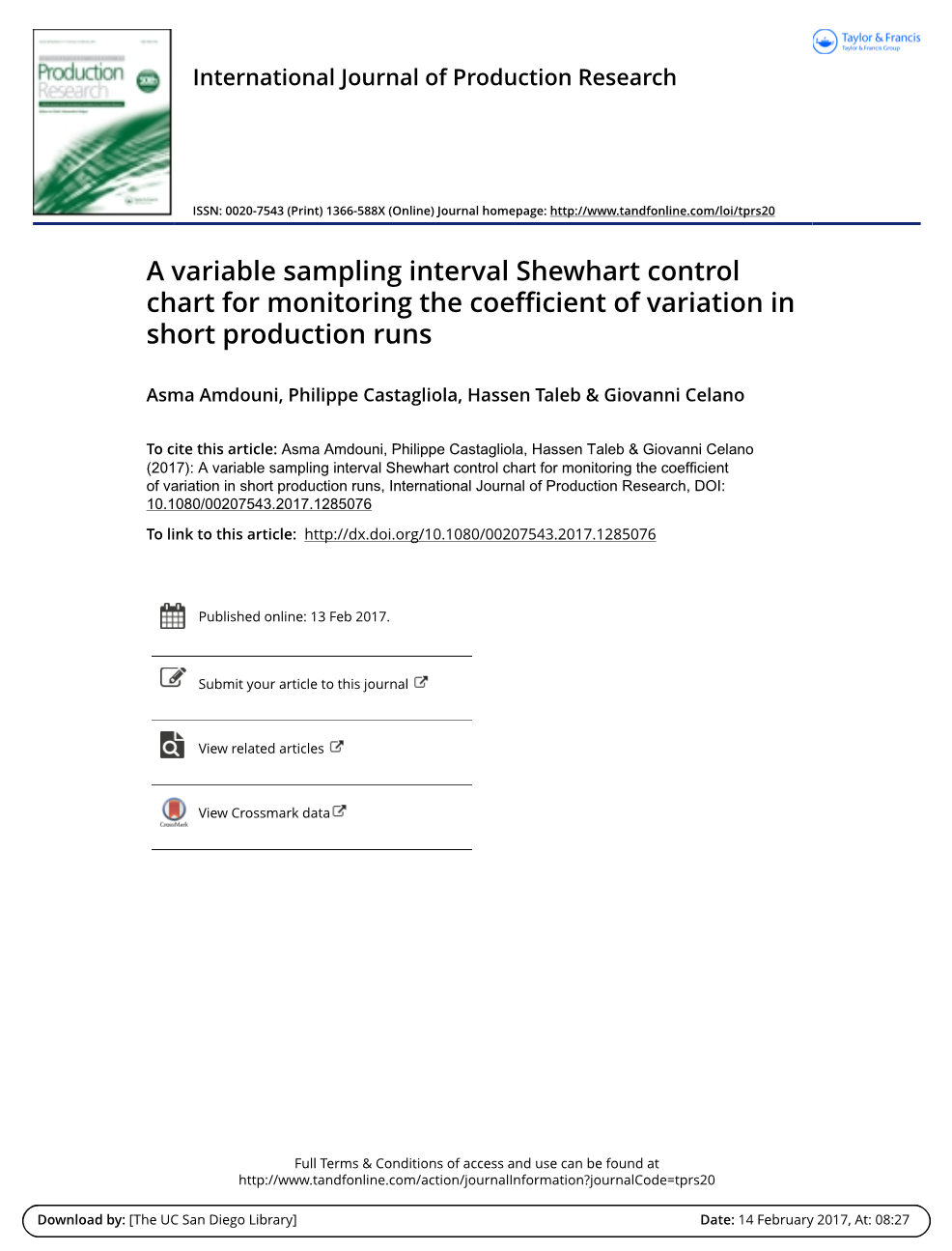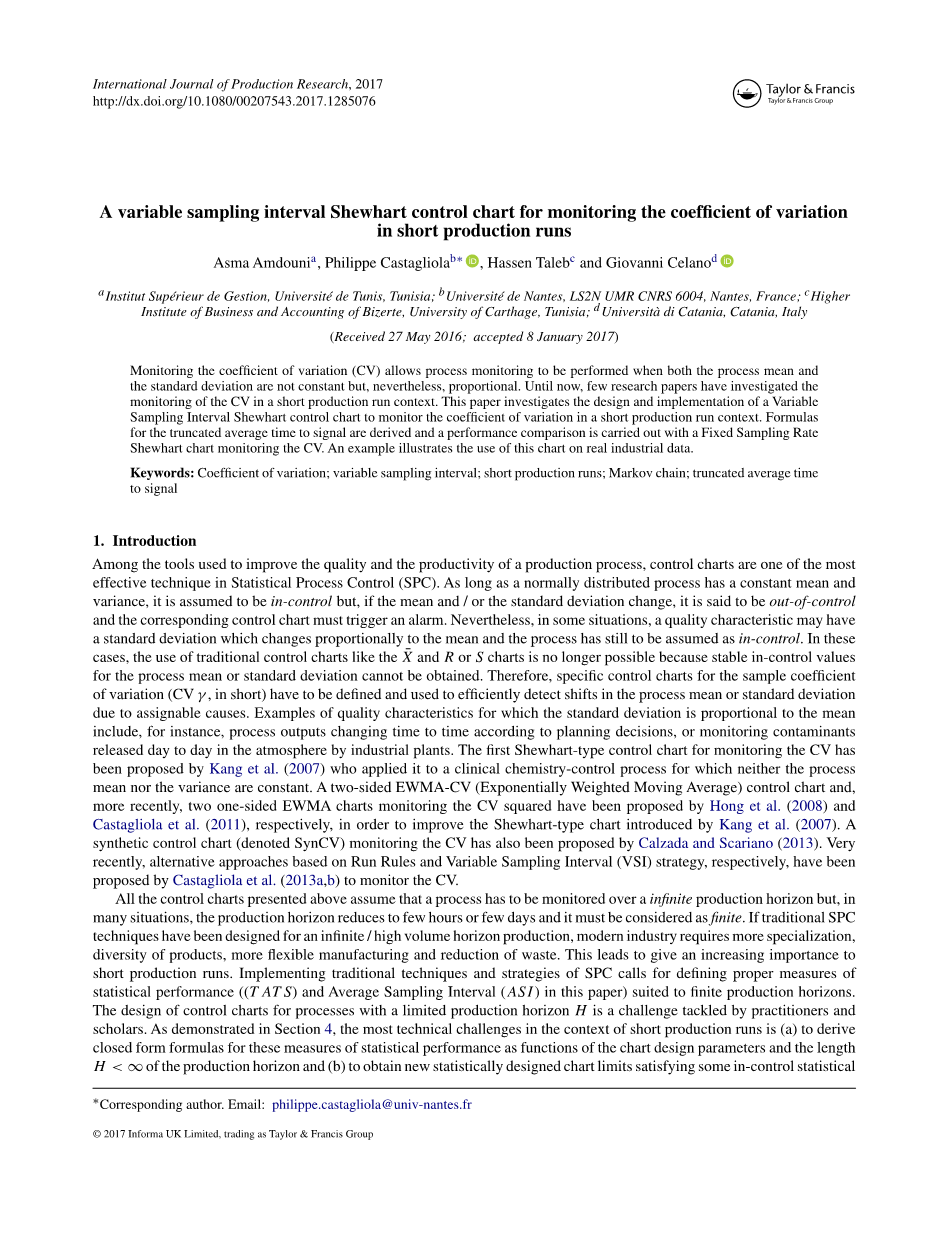

英语原文共 17 页,剩余内容已隐藏,支付完成后下载完整资料
A variable sampling interval Shewhart control chart for monitoring the coefficient of variation
in short production runs
Asma Amdouni, Philippe Castagliolalowast; , Hassen Taleb and Giovanni Celano
Abstract: Monitoring the coefficient of variation (CV) allows process monitoring to be performed when both the process mean and the standard deviation are not constant but, nevertheless, proportional. Until now, few research papers have investigated the monitoring of the CV in a short production run context. This paper investigates the design and implementation of a Variable Sampling Interval Shewhart control chart to monitor the coefficient of variation in a short production run context. Formulas for the truncated average time to signal are derived and a performance comparison is carried out with a Fixed Sampling Rate Shewhart chart monitoring the CV. An example illustrates the use of this chart on real industrial data.
Keywords: Coefficient of variation; variable sampling interval; short production runs; Markov chain; truncated average time to signal
1. Introduction
Among the tools used to improve the quality and the productivity of a production process, control charts are one of the most effective technique in Statistical Process Control (SPC). As long as a normally distributed process has a constant mean and variance, it is assumed to be in-control but, if the mean and / or the standard deviation change, it is said to be out-of-control and the corresponding control chart must trigger an alarm. Nevertheless, in some situations, a quality characteristic may have a standard deviation which changes proportionally to the mean and the process has still to be assumed as in-control. In these cases, the use of traditional control charts like theand R or S charts is no longer possible because stable in-control values for the process mean or standard deviation cannot be obtained. Therefore, specific control charts for the sample coefficient of variation (CV gamma; , in short) have to be defined and used to efficiently detect shifts in the process mean or standard deviation due to assignable causes. Examples of quality characteristics for which the standard deviation is proportional to the mean include, for instance, process outputs changing time to time according to planning decisions, or monitoring contaminants released day to day in the atmosphere by industrial plants. The first Shewhart-type control chart for monitoring the CV has been proposed by Kang et al. (2007) who applied it to a clinical chemistry-control process for which neither the process mean nor the variance are constant. A two-sided EWMA-CV (Exponentially Weighted Moving Average) control chart and, more recently, two one-sided EWMA charts monitoring the CV squared have been proposed by Hong et al. (2008) and Castagliola et al. (2011), respectively, in order to improve the Shewhart-type chart introduced by Kang et al. (2007). A synthetic control chart (denoted SynCV) monitoring the CV has also been proposed by Calzada and Scariano (2013). Very recently, alternative approaches based on Run Rules and Variable Sampling Interval (VSI) strategy, respectively, have been proposed by Castagliola et al. (2013a,b) to monitor the CV.
All the control charts presented above assume that a process has to be monitored over a infinite production horizon but, in many situations, the production horizon reduces to few hours or few days and it must be considered as finite. If traditional SPC techniques have been designed for an infinite / high volume horizon production, modern industry requires more specialization, diversity of products, more flexible manufacturing and reduction of waste. This leads to give an increasing importance to short production runs. Implementing traditional techniques and strategies of SPC calls for defining proper measures of statistical performance ((T AT S) and Average Sampling Interval (ASI ) in this paper) suited to finite production horizons. The design of control charts for processes with a limited production horizon H is a challenge tackled by practitioners and scholars. As demonstrated in Section 4, the most technical challenges in the context of short production runs is (a) to derive closed form formulas for these measures of statistical performance as functions of the chart design parameters and the length H lt; infin;of the production horizon and (b) to obtain new statistically designed chart limits satisfying some in-control statistical performances. Examples of processes with finite production horizon can be found in many industrial sectors: automotive industry (production of mechanical components within flexible manufacturing cells), semiconductor industry (assembly of electronic boards), ...Another example of short production runs is high volume manufacturing processes with a low inspection rate in which the production of a particular product is so short that the number of possible inspections is limited to a few. A good example of such a process is a bottling soft drinks process for which set-ups can occur every 1 or 2 days to change brand and packaging. Although the production rate is high, (thousands of bottles/cans per hour), only a limited number of bottles/cans of the same brand and package can be inspected every hour due to time required by the test used to get the correct value of dissolved inside one bottle. This constraint clearly limits the number of scheduled inspections between two consecutive set-ups to 20 or 30 maximum. In this context, where samples are gathered with large sampling intervals, it is reasonable to assume that the data from two consecutive samples are statistically independent.
Ladany (1973) was the first to propose control charts specifically designed for finite production run processes for the economic optimization of a p-chart. Later, Ladany and Bedi (1976) extended this work to allow the
剩余内容已隐藏,支付完成后下载完整资料
资料编号:[19906],资料为PDF文档或Word文档,PDF文档可免费转换为Word


